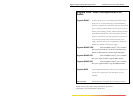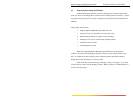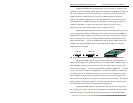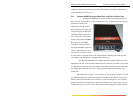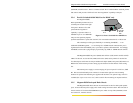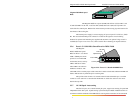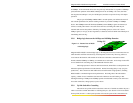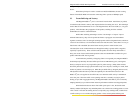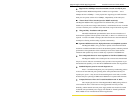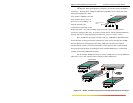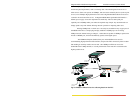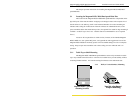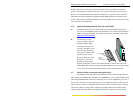
Magnum DS50 / DS60s Dual Speed Hubs Installation and User Guide (06/02)
The up-link operates the same, whether Port # 1 is connected to either a 100Mbps or 10Mbps
device.
When the up-link port is used to cascade two DS50 / DS60 hubs, the auto-sensing
feature of the DS50 / DS60 will cause the connecting link to operate at 100Mbps speed.
2.3 Frame Buffering and Latency
The Magnum DS60’s 6
th
port is a store-and-forward switch. Each frame (or packet)
is loaded into the Switch’s memory and inspected before forwarding can occur. This technique
ensures that all forwarded frames are of a valid length and have the correct CRC (i.e., are good
packets). This eliminates the propagation of bad packets, enabling all of the available
bandwidth to be used for valid information.
While other switching technologies such as "cut-through" or "express" impose
minimal frame latency, they will also permit bad frames to propagate out to the Ethernet
segments connected. The "cut-through" technique permits collision fragment frames, which are
a result of late collisions, to be forwarded to add to the network traffic. Since there is no way to
filter frames with a bad CRC (the entire frame must be present in order for CRC to be
calculated), the result of indiscriminate cut-through forwarding is greater traffic congestion,
especially at peak activity. Since collisions and bad packets are more likely when traffic is
heavy, the result of store-and-forward operation is that more bandwidth is available for good
packets when the traffic load is greatest.
To minimize the possibility of dropping frames on congested ports, Magnum DS60’s
Switched port dynamically allocates buffer space from an 1MB memory pool, ensuring that
heavily used ports receive very large buffer space for packet storage. (Many other switches
have their packet buffer storage space divided evenly across all ports, resulting in a small, fixed
number of packets to be stored per port. When the port buffer fills up, dropped packets result.)
This dynamic buffer allocation provides the capability for the maximum resources to the
DS60’s 6
th
port to be applied to all traffic loads, even when the traffic activity is unbalanced
across the ports. Since the traffic on an operating network is constantly varying in packet
density per port and in aggregate density, the Magnum DS60’s Switched 6
th
port is constantly
adapting internally to provide maximum network performance with the least dropped packets.
When the Switch detects that its free buffer queue space is low, the Switch sends
industry standard (full-duplex only) PAUSE packets out to the devices sending packets to cause
“flow control”. This tells the sending devices to temporarily stop sending traffic, which allows
a traffic catch-up to occur without dropping packets. Then, normal packet buffering and
12
www GarrettCom com
..



